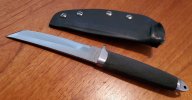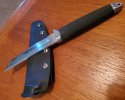Most of the sheaths I make are pancake style kydex. I like to be able, especially with kydex, the ability to pull the sheath apart to clean grit out. It is for this reason I use the common kydex screws rather than rivets or eyelets. I have found all these screws to have rather large, like 10mm heads, this requires are wide seam at the edges of the sheath. I was wondering if anyone had tried screws with a smaller head diameter? That would allow for a thinner seam. Anything countersunk would just pull through under pressure, but a smaller flat head should work. I was thinking smaller button heads with threaded tube as a post. Or even a metal seam that smaller screws can thread into, looking for ideas to thin out those seams and make nice narrow profile sheaths. I love the sleek look and feel of a taco but I find they get grit in the seams.
-
The BladeForums.com 2024 Traditional Knife is ready to order! See this thread for details: https://www.bladeforums.com/threads/bladeforums-2024-traditional-knife.2003187/
Price is$300$250 ea (shipped within CONUS). If you live outside the US, I will contact you after your order for extra shipping charges.
Order here: https://www.bladeforums.com/help/2024-traditional/ - Order as many as you like, we have plenty.
You are using an out of date browser. It may not display this or other websites correctly.
You should upgrade or use an alternative browser.
You should upgrade or use an alternative browser.
Small kydex screws
- Thread starter elasmonut
- Start date
RokJok
Gold Member
- Joined
- Oct 6, 2000
- Messages
- 4,187
How committed to finding an alternative are you? How complex/expensive a solution can you tolerate? Do your sheaths have a welt/spacer on the edge side of the pancake?
Here are some off the top of my head thoughts.
- chuck Chicago screw parts (one side at a time) in a drill press or clamped down hand drill and use a file to reduce flange diameter of the spinning part to a size you like. Sandpaper to polish if you think it appropriate.
- * complex approach *. Grind opposite edges of Chicago screws m/f part flanges into more rectangular shape aligned with edge of sheath to allow trimming off more of sheath edge. To do this, you'd mark & drill sheath with wide sheath flange not yet trimmed up. Establish & drill fastening screw holes as close in as you'd like. Insert & tighten screws to final tension. Now mark screw flanges top & bottom of sheath *in line parallel with eventual edge of sheath* to outside diameter of female threaded post. For marking I recommend Dykem layout fluid & scratch awl. Now unscrew each screw, keeping each pair together, because the orientation of each screw vis-a-vis eventual sheath edge will be unique. Grind/file circular screw flanges to scratch lines & reinsert screws in their particular hole. Now trim excess sheath flange close to rectangular'ish screw heads.
Edit to add: Now that I thought a bit more, it would be easier, simpler, and more efficient to simply simultaneously grind sheath edge & screw flange to final profile at the same time. That avoids all the complex sequential steps of this option.
- drill & tap a metal strip to sandwich between the front & back of the sheath along the line of screws, sorta like clip nuts as used on cars. Alternate screw locations to avoid butting the screws into each other. Drills & taps can be found in very small sizes (think jewelers and optics worlds). I've gotten a tap set M1-M3.5 by Wolfride on Amazon, along with appropriate size drill bits. Yakamoz is another brand there that gets good grades. I used M2 tap IIRC to tap inside of a *tiny* roll pin in an ignition assembly so I could use itty bitty screw to extract the pin. I used a 1/4" hex converter mini chuck as the tap handle. Just spun it slowly & carefully in my fingers. One turn in, half turn out, one turn in, half turn out, ... and being VERY sensitive to tactile feedback from my fingertips. *TAPPING FLUID IS MANDATORY!* Those tiny taps can snap at a thought.
- if money is no barrier, machine shop can make/modify a fastener to meet your needs. But $$ there could be used to buy more knives. So low priority on this option.
Here are some off the top of my head thoughts.
- chuck Chicago screw parts (one side at a time) in a drill press or clamped down hand drill and use a file to reduce flange diameter of the spinning part to a size you like. Sandpaper to polish if you think it appropriate.
- * complex approach *. Grind opposite edges of Chicago screws m/f part flanges into more rectangular shape aligned with edge of sheath to allow trimming off more of sheath edge. To do this, you'd mark & drill sheath with wide sheath flange not yet trimmed up. Establish & drill fastening screw holes as close in as you'd like. Insert & tighten screws to final tension. Now mark screw flanges top & bottom of sheath *in line parallel with eventual edge of sheath* to outside diameter of female threaded post. For marking I recommend Dykem layout fluid & scratch awl. Now unscrew each screw, keeping each pair together, because the orientation of each screw vis-a-vis eventual sheath edge will be unique. Grind/file circular screw flanges to scratch lines & reinsert screws in their particular hole. Now trim excess sheath flange close to rectangular'ish screw heads.
Edit to add: Now that I thought a bit more, it would be easier, simpler, and more efficient to simply simultaneously grind sheath edge & screw flange to final profile at the same time. That avoids all the complex sequential steps of this option.
- drill & tap a metal strip to sandwich between the front & back of the sheath along the line of screws, sorta like clip nuts as used on cars. Alternate screw locations to avoid butting the screws into each other. Drills & taps can be found in very small sizes (think jewelers and optics worlds). I've gotten a tap set M1-M3.5 by Wolfride on Amazon, along with appropriate size drill bits. Yakamoz is another brand there that gets good grades. I used M2 tap IIRC to tap inside of a *tiny* roll pin in an ignition assembly so I could use itty bitty screw to extract the pin. I used a 1/4" hex converter mini chuck as the tap handle. Just spun it slowly & carefully in my fingers. One turn in, half turn out, one turn in, half turn out, ... and being VERY sensitive to tactile feedback from my fingertips. *TAPPING FLUID IS MANDATORY!* Those tiny taps can snap at a thought.
- if money is no barrier, machine shop can make/modify a fastener to meet your needs. But $$ there could be used to buy more knives. So low priority on this option.
Last edited:
RokJok
Gold Member
- Joined
- Oct 6, 2000
- Messages
- 4,187
Perhaps some help in this old post here on BF.
Good answer, pretty much a summary of my ideas, thankyou, Im leaning towards tapped metal liner, for a pancake style. Or a two part "mora" style sheath that opens with one or two screws. Might even try some smaller screws with washers/ threaded spacers, maybe incorporated with a metal "utiliclip" style belt loop.How committed to finding an alternative are you? How complex/expensive a solution can you tolerate? Do your sheaths have a welt/spacer on the edge side of the pancake?
Here are some off the top of my head thoughts.
- chuck Chicago screw parts (one side at a time) in a drill press or clamped down hand drill and use a file to reduce flange diameter of the spinning part to a size you like. Sandpaper to polish if you think it appropriate.
- * complex approach *. Grind opposite edges of Chicago screws m/f part flanges into more rectangular shape aligned with edge of sheath to allow trimming off more of sheath edge. To do this, you'd mark & drill sheath with wide sheath flange not yet trimmed up. Establish & drill fastening screw holes as close in as you'd like. Insert & tighten screws to final tension. Now mark screw flanges top & bottom of sheath *in line parallel with eventual edge of sheath* to outside diameter of female threaded post. For marking I recommend Dykem layout fluid & scratch awl. Now unscrew each screw, keeping each pair together, because the orientation of each screw vis-a-vis eventual sheath edge will be unique. Grind/file circular screw flanges to scratch lines & reinsert screws in their particular hole. Now trim excess sheath flange close to rectangular'ish screw heads.
Edit to add: Now that I thought a bit more, it would be easier, simpler, and more efficient to simply simultaneously grind sheath edge & screw flange to final profile at the same time. That avoids all the complex sequential steps of this option.
- drill & tap a metal strip to sandwich between the front & back of the sheath along the line of screws, sorta like clip nuts as used on cars. Alternate screw locations to avoid butting the screws into each other. Drills & taps can be found in very small sizes (think jewelers and optics worlds). I've gotten a tap set M1-M3.5 by Wolfride on Amazon, along with appropriate size drill bits. Yakamoz is another brand there that gets good grades. I used M2 tap IIRC to tap inside of a *tiny* roll pin in an ignition assembly so I could use itty bitty screw to extract the pin. I used a 1/4" hex converter mini chuck as the tap handle. Just spun it slowly & carefully in my fingers. One turn in, half turn out, one turn in, half turn out, ... and being VERY sensitive to tactile feedback from my fingertips. *TAPPING FLUID IS MANDATORY!* Those tiny taps can snap at a thought.
- if money is no barrier, machine shop can make/modify a fastener to meet your needs. But $$ there could be used to buy more knives. So low priority on this option.
vjb.knife
Platinum Member
- Joined
- Feb 2, 2002
- Messages
- 1,685
GrumpySoreOldBastard
Gold Member
- Joined
- Nov 27, 2024
- Messages
- 75
Here is a option.

 www.aliexpress.com
www.aliexpress.com

10pcs/lot M3 M4 M5 M6 M8 Black Zin Plated Large Flat Hex Hexagon Socket Head Rivet Connector Insert Joint Sleeve Cap Butt Nut - AliExpress 13
Smarter Shopping, Better Living! Aliexpress.com
- Joined
- Apr 28, 2024
- Messages
- 27
I was just at a Tandy Leather store today, and they had some small Chicago screws. Head was probably less than 1/4". Don't know if they have them on their website, but they were in the store.


